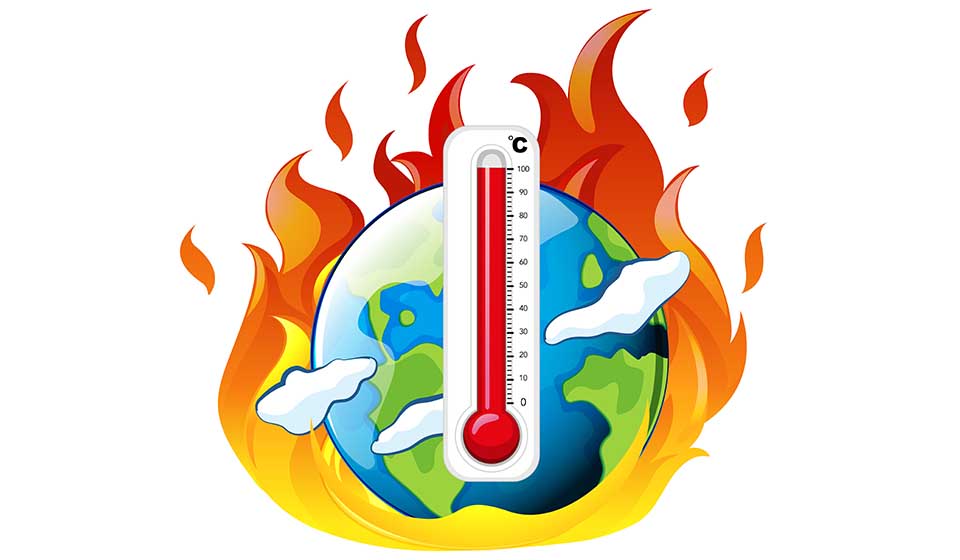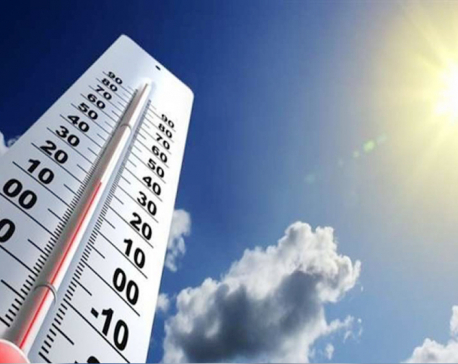
OR
Hottest day on record: Global temperatures continue to rise
Published On: July 6, 2023 03:00 PM NPT By: SHREE RAM SUBEDI

KATHMANDU, July 6: On Monday, a significant milestone was reached as the planet experienced its hottest day since the start of daily temperature records. The Earth's surface reached a maximum temperature of 17.01 degrees Celsius, surpassing the previous record of 16.9 degrees Celsius set in August 2016.
According to the US National Center for Environmental Prediction, the warming effects of both the climate phenomenon known as 'El Niño' and the excessive emission of carbon dioxide from human activities are identified as the primary factors behind the rising global temperatures.
Scientists employ various methods to measure the average temperature of the Earth's surface, including gathering updated data from different regions such as land and sea. Since satellite monitoring began in 1979, temperature measurement has provided valuable insights, while surface temperature records have been collected mechanically since the late 19th century.
In response to this concerning trend, the World Meteorological Organization (WMO) issued a statement on Tuesday, highlighting the re-emergence of the El Niño weather system after a seven-year hiatus. This climate pattern is projected to further elevate temperatures in the eastern and central Pacific region. Petteri Taalas, the secretary-general of the organization, expressed concern that this El Niño event could surpass previous temperature records and called upon governments worldwide to take necessary precautions.
As the El Niño phenomenon takes hold, governments worldwide are recognizing the imperative to make necessary preparations to mitigate its impact on human health, ecological systems, and the economy. Secretary-General Taalas emphasized the importance of developing early warning systems and disaster preparedness to safeguard both lives and livelihoods against the repercussions of extreme weather events.
Local and Regional Consequences
Ahead of the monsoon season, Nepal and India faced scorching temperatures, leading to unfortunate casualties in India attributed to the blistering heat. According to data from the Department of Hydrology and Meteorology, Nepal recorded the highest temperature this year at 43.8 degrees Celsius in Dumkauli in Nawalpur.
Similarly, China has witnessed a concerning surge in temperatures in recent years, with records being shattered and heat waves intensifying. Just last week, China grappled with a heat wave exceeding 35 degrees Celsius, further highlighting the escalating impact of hot air masses.
In a report released by the Intergovernmental Panel on Climate Change (IPCC) last March, it was highlighted that Earth's temperature is projected to increase by 1.5 degrees Celsius in the foreseeable future. The report emphasizes the critical need to reduce greenhouse gas emissions by 60 percent by 2035, measured against 2019 levels, in order to halt the upward trajectory of temperatures.
Adding to these concerns, a recent study titled 'Water, Snow, Society, and Ecosystem of the Hindu Kush Himalaya Region,' published by the International Centre for Integrated Mountain Development (ICIMOD), issued a stark warning. The study revealed that if the current pace of global temperature increase persists, approximately 80 percent of the ice in the glaciers of the Hindu Kush region will vanish by the end of this century. The research underscores the devastating consequences of global warming, which has already triggered "unprecedented and largely irreversible" changes in glaciers, ice, and frozen ground in recent years.
A message to Nepal
Indira Kandel, a senior meteorologist from the Department of Hydrology and Meteorology, emphasizes the need for comprehensive preparation and scientifically sound physical infrastructure development as climate risks continue to escalate. Kandel highlights that considering the potential impact of climate change is crucial when undertaking construction projects such as roadways and hydroelectricity facilities.
Kamal Ram Joshi, the director general of the department, underscores the importance of studying the increasing temperatures on a domestic scale in Nepal, referencing multiple international scientific studies that confirm the global temperature rise. It is estimated that Nepal will experience a yearly temperature increase of up to 0.056 degrees Celsius, with the high Himalayan region expected to see a higher rise of 0.086 degrees Celsius. Joshi emphasizes the necessity of on-site monitoring and studies to assess the impact of these temperature changes in Nepal, aligning with the latest international research.
Devesh Tripathi, former director general of the forest department, draws attention to the migration of trees, plants, and animals to higher elevations as temperatures continue to climb. While habitat expansion presents opportunities for some species, others struggle to adapt to these new locations. Tripathi, who recently retired from service, suggests the need for further scientific research and study on this subject matter.
You May Like This

Temperature in Kathmandu Valley to remain high today as well
KATHMANDU, June 13: Weather in the eastern part of the country is currently experiencing an influence of the monsoon system.... Read More...

Cyclone Phethai brings to Valley this winter's coldest day yet
KATHMANDU, Dec 18: Since the start of winter, Kathmandu Valley residents are to be seen soaking in the sun whenever... Read More...

Valley temperature drops to 2.8 degrees Celsius; Saturday, coldest day so far of the year
KATHMANDU, Dec 16: Winter cold has set in, in the entire country including the Kathmandu Valley, with the fall in... Read More...






Just In
- Challenges Confronting the New Coalition
- NRB introduces cautiously flexible measures to address ongoing slowdown in various economic sectors
- Forced Covid-19 cremations: is it too late for redemption?
- NRB to provide collateral-free loans to foreign employment seekers
- NEB to publish Grade 12 results next week
- Body handover begins; Relatives remain dissatisfied with insurance, compensation amount
- NC defers its plan to join Koshi govt
- NRB to review microfinance loan interest rate











Leave A Comment